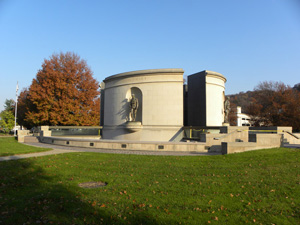

Remember...
Bobby Neal Hiser
1925-1944
"If a man does his best, what else is there?"
Gen. George S. Patton
 |
Remember...Bobby Neal Hiser
|
Bobby Neal Hiser was born March 29, 1925, to Boyd Striet Hiser and Lina Ellen Pearl Smith Hiser in Morgantown, Monongalia County, West Virginia. In 1930, according to the U.S. Federal Census, Boyd Hiser was a truck driver for a milk supply company. Pearl Hiser did not have a job outside the home. Bobby Hiser had a younger brother Darwin and an older brother Boyd Hiser Jr.
At the time of the 1940 census, Boyd, Pearl, Junior, Bobby, and Darwin still lived in Morgantown and were joined by the wife of Boyd Jr., Izetta Hiser. Boyd Hiser was working in retail dairy products sales, and Boyd Jr. was working in retail meat sales, both truck drivers. No one else worked outside the home.
According his World War II draft card, Bobby Neal Hiser registered on his birthday in 1943. He indicated he was a student, with blonde hair and gray eyes. U.S. World War II Army Enlistment Records, 1938-1946, show that Bobby Neal Hiser enlisted in Clarksburg, West Virginia, on August 19, 1943. His Army enlistment record notes he had had four years of high school, was single, and had no dependents.
No record could be found of his route from his home in West Virginia to France, but his headstone tells part of his tale. He was with Patton's 3rd Army, 90th Reconnaissance Troop (Mech), and fought during World War II in France.
The 90th was activated in 1942, but didn't ship out until March of 1944. Some elements of the 90th fought in Normandy on D-Day, so it is likely, though not a certainty, that Bobby Hiser was part of that world-changing event. By September the 90th had crossed into France and headed toward Metz. Though no records were found that directly place Bobby Neal Hiser in Metz, France, this seems the most likely location of the last large offensive in which he fought. ("90th Infantry Division," Combat Reels, accessed 1 August 2017, http://www.combatreels.com/90th_infantry_division.cfm.)
The Battle of Metz was an important one because the area was firmly in the way of an Allied advance into Germany. The heavily fortified city had passed as a claim of Germany to France over the generations, and was, in the late fall of 1944, once again German territory. The fall of 1944 in this area was wet and cold, and the ground muddy. Supply lines were hampered, and General Patton frustrated by a lack of fuel and ammunition. ("Patton's Third Army Resumes the Attack:Towards Metz," World War II Today, accessed 1 August 2017, http://ww2today.com/8-november-1944-pattons-third-army-resumes-the-attack-towards-metz.) On November 9, General Patton's troops and tanks crossed the Moselle River and were poised to go into Metz.
The day of the 16th was a rare sunny day, which cleared the way for airborne support. It was on this day that Bobby Hiser was injured. He died on November 18.
By the 23rd, Metz was taken. ("Timeline of World War II [1944]," Wikipedia, accessed 1 August 2017, https://en.wikipedia.org/wiki/Timeline_of_World_War_II_(1944)#November_1944).)
The following synopsis explains the importance of the fall of Metz:
The fall of Metz marked a great milestone in the historic route of the XX Corps. The courage and fighting qualities of the XX Corps troops had resulted in a smashing of another "hold or die", Hitler inspired defense system. The loss of Metz and its encircling rings of mighty forts, and the breaching of the Moselle along a broad front, though at one of its highest flood stages in history, spelled a major disaster for the German war machine. The months of planning by the Corps staff and the daring but accurate decisions had paid off once more in great triumph. The 1500-year tradition of inviolability of the citadel of Metz was destroyed for all time.In losing Metz, the German Armies lost strategic hinge on which they had hoped to anchor their line on the Western front. Before XX Corps now lay the German border and the Siegfried Line. The battle for France was drawing to an end, a fatal end for the Nazis. Corps columns were already pounding their way to the Saar. The opening rounds of the Battle of Germany were beginning.
The fall of its last great stronghold in France was, moreover, a stunning psychological blow to the German state. Metz was more than a great armored shield against the hammer blows of the XX Corps. It was an historic symbol of victory in arms, a good luck talisman for victorious armies through centuries of war-torn history. ("Partial History of the XX Corps, United States Third Army," accessed 1 August 2017, http://www.90thdivisionassoc.org/afteractionreports/PDF/XXCorpsHist.pdf.)
Article prepared by Cynthia Mullens
2017

West Virginia Archives and History welcomes any additional information that can be provided about these veterans, including photographs, family names, letters and other relevant personal history.